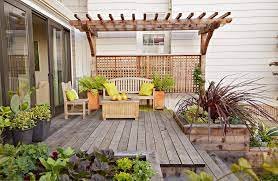Transform small, sloped yards into functional, beautiful spaces with creative design, proper planning, and erosion control. This guide offers practical tips to make the most of your outdoor area.
Planning and Design Considerations for Small Yards
Small yards require thoughtful planning to maximize both function and visual appeal. Start by measuring your space and creating a detailed sketch that includes existing features like trees, structures, and utilities.
Vertical gardening transforms limited ground space into lush growing areas. Install wall-mounted planters, trellises, and hanging baskets to draw the eye upward and create the illusion of expanded space. Consider multi-level raised beds that provide planting depth while adding architectural interest.
Zone creation helps small yards feel larger and more organized. Divide your space into distinct areas—perhaps a seating zone, herb garden, and play area. Use different materials, plant heights, or decorative elements to define these spaces without physical barriers that make the yard feel cramped.
Smart storage solutions keep small yards functional. Built-in benches with hidden storage, vertical tool organizers, and compact shed alternatives prevent clutter while maintaining the space’s aesthetic appeal.
Plant Selection for Small Spaces
Choosing the right plants can make or break a small yard design. Focus on varieties that provide maximum impact without overwhelming the space.
Multi-season plants offer year-round interest in compact areas. Select trees and shrubs that provide spring flowers, summer foliage, fall color, and interesting winter bark or structure. Japanese maples, ornamental cherries, and compact evergreens work exceptionally well in small spaces.
Dwarf and compact varieties of popular plants allow you to enjoy favorite species without size concerns. Dwarf fruit trees provide fresh produce, while compact roses deliver fragrance and color without sprawling growth habits.
Container gardening adds flexibility to small yard designs. Large pots and planters can be rearranged seasonally, allow for soil control, and create instant focal points. Group containers of varying heights and sizes for visual impact.
Consider plants that serve multiple purposes. Fragrant herbs provide cooking ingredients and pleasant scents, while flowering vegetables add beauty alongside fresh produce.
Sloped Yard Landscaping Techniques
Sloped yards require specialized approaches that work with gravity rather than against it. Understanding your slope’s grade and drainage patterns is essential before beginning any landscaping project.
Terracing creates level planting areas on steep slopes while adding dramatic visual appeal. Build retaining walls using stone, timber, or manufactured blocks to create stepped gardens. Each terrace can serve different purposes—vegetables on one level, flowers on another, and seating areas where appropriate.
Groundcover solutions prevent soil erosion while reducing maintenance. Choose spreading plants with strong root systems like creeping phlox, pachysandra, or ornamental grasses. These plants establish quickly and create attractive coverage that requires minimal upkeep once established.
Meandering pathways make sloped yards accessible and safe. Install switchback paths with gentle grades rather than straight, steep walkways. Use materials like flagstone, gravel, or pressure-treated lumber to create stable walking surfaces.
Professional consultation may be necessary for steep slopes or areas requiring extensive earth moving. Tree services like those in Salt Lake City can assess large tree stability on slopes and recommend appropriate plantings for challenging terrain.
Erosion Control and Water Management on Slopes
Water management is crucial for sloped yard success. Poor drainage can lead to erosion, plant failure, and structural problems for nearby buildings.
Rain gardens capture and filter runoff while creating attractive planted areas. Position these shallow depressions at the bottom of slopes to collect water naturally. Plant with native species that tolerate both wet and dry conditions.
Permeable surfaces allow water infiltration while providing functional outdoor space. Consider permeable pavers, gravel pathways, or porous concrete for patios and walkways on slopes.
Strategic plant placement helps control water flow. Deep-rooted plants near the top of slopes slow water movement, while moisture-loving varieties at the bottom handle collected runoff. Native grasses and sedges are particularly effective for slope stabilization.
Install French drains or other drainage systems if natural solutions aren’t sufficient. These underground systems redirect water safely away from problem areas.
Adding Functional and Aesthetic Elements
Small and sloped yards benefit from carefully chosen features that serve multiple purposes while adding visual interest.
Multi-level decking creates usable outdoor living space on slopes while providing access to different yard areas. Design decks to follow the natural contours of your slope for integration that feels organic rather than imposed.
Fire features extend outdoor enjoyment into cooler months. Fire pits or outdoor fireplaces work well on level areas of sloped yards, creating natural gathering spaces. Ensure proper clearance from structures and vegetation.
Water features add movement and sound to challenging landscapes. Small fountains, cascading waterfalls, or stream beds work beautifully on slopes, using gravity to create natural water flow.
Lighting design transforms both small and sloped yards after dark. Use LED path lighting for safety on slopes, accent lighting to highlight plantings or features, and ambient lighting in seating areas.
Built-in seating maximizes functionality without consuming precious space. Retaining walls can double as benches, while built-in planters can include integrated seating edges.
Conclusion
Turn small or sloped yards into functional, beautiful spaces by addressing challenges like erosion and space limits. Start with essentials like drainage and pathways, then add plants and decor over time to create a unique outdoor area.








